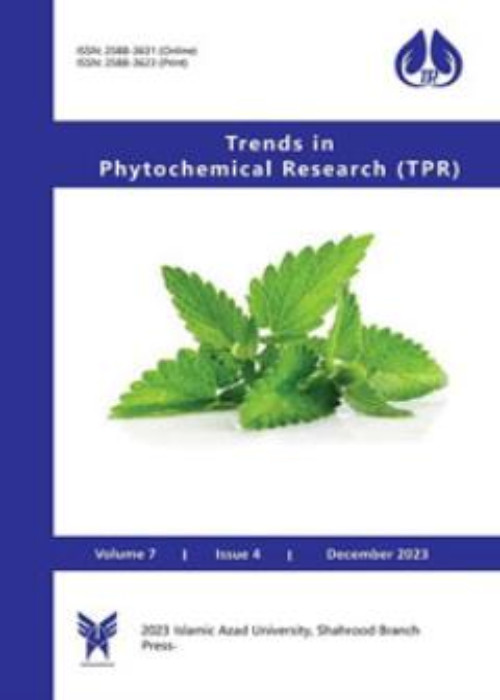فهرست مطالب
Trends in Phytochemical Research
Volume:7 Issue: 3, Summer 2023
- تاریخ انتشار: 1402/06/10
- تعداد عناوین: 6
-
-
Pages 141-155
Ammi visnaga (L.) Lam., (Apiaceae), known as” Bachnikha” or ”Khella” in Morocco, is one of the oldest and most important medicinal herbs native to the Mediterranean region of Asia, Europe, and North Africa. Several studies have reported its importance as a diuretic, antiasthmatic, antipsoriasis, antioxidant, antifungal, antibacterial, vasodilator, and smooth muscle relaxant. These promising and valuable pharmacological effects result from a variety of important natural compounds constituting groups in the plant structure, e.g., γ-pyrones, coumarins, chromones, polyphenols, alkaloids, reducing compounds, cardiac glycosides, catechols, sterols, terpenes, quinones, mucilage, essential oil, C-heterosides, and O-heterosides. Within this framework, the current review was prepared for the first time to cover the phytochemical constituents and various pharmacological and therapeutic impacts of A. visnaga (L.) Lam., aiming to enrich Moroccan traditional knowledge.
Keywords: Ammi visnaga (L.) Lam, Antioxidant activities, Biological effects, Ethnobotanical uses, Pharmacological uses, Phytochemistry -
Pages 156-169
Rosmarinus officinalis L. is a perennial herb, known for culinary as well as medicinal properties. It has been shown that bioactive compounds like rosmarinic acid, carnosic acid, and carnosol are responsible for the medicinal properties of this plant species. Carnosic acid is a phenolic diterpene synthesized in young leaves of rosemary, whereas carnosol is produced after the oxidation of carnosic acid. Several studies have confirmed their antiangiogenic, anti-inflammatory, antimicrobial, antidiabetic, antioxidant, antitumor, neuroprotective, and gastroprotective properties. Ethanol, a mixture of ethanol-acetone, and hexane have been recommended as the best solvents for the extraction of carnosic acid, but advanced extraction techniques such as microwave-assisted extraction (MAE), ultrasound-assisted extraction (UAE), pressurized liquid extraction (PLE), supercritical fluid extraction (SFE), etc. have been used to extract these phenolic antioxidant compounds in higher yield. This report is a kind of first study that emphasizes the recent research on the pharmacological potentials of carnosic acid and carnosol and summarizes the studies on modern extraction procedures.
Keywords: Bioactivities, Biological activity, Carnosic acid, Carnosol, lamiaceae, Rosmarinus officinalis L, Secondary metabolites -
Pages 170-185
Wounds have a significant detrimental influence on the economics of a country’s health care system, particularly in developing nations with limited resources. However, there is no effective evidence-based treatment for wounds that may result in evident clinical results. As a result, complementary and alternative medicines (CAMs) such as natural products, which include plant-derived extracts (phytochemicals), and naturally derived substances have intrigued the attention of researchers. Numerous plant extracts and their phytoconstituents are recognized as viable options for wound healing because they possess anti-inflammatory, antioxidant, angiogenic, and cell synthesis-modulating properties. Additionally, using plants with medicinal characteristics to treat wounds has been demonstrated to be effective in combating infection and accelerating wound healing. Thus, this study strives to fill the gaps in the current literature and provides researchers the creation of safe, efficacious, and universally acknowledged herbal medications for a vast array of cuts and wounds.
Keywords: Healthcare, Herbal extracts, Medicinal Plants, phytochemicals, Wound healing, wound management -
Pages 186-206Chromolaena odorata (L.), locally named Siam weed, is a rich source of phyto-bioactives and has been traditionally used for wound healing. This study deals with the phytochemical investigation of the leaves of C. odorata (L.) for their antioxidant, anti-inflammatory, and antibacterial properties that contribute to the observed wound healing properties. The phytoconstituents were sequentially extracted from the powdered leaves of C. odorata (L.) and chemoprofiled using the LC-MS technique. Furthermore, copper oxide/copper nanoparticles (CuNPs) were synthesized by the use of water extracts from the leaves of C. odorata (L.), characterized and evaluated for their potential biological and wound healing impacts. In this relation, scutellarein, isosakuranetin, and rutin, along with 15 other phytoconstituents were identified. Higher antioxidant (79.2% at 200 μg/mL) and anti-inflammatory potentials (66.8%) were obtained for CuNPs (120 μg/mL), in the size range of 66.8 ± 24.8 nm. Antibacterial activity against methicillin-resistant Staphylococcus aureus and Pseudomonas sp. demonstrated mean zones of inhibition of 16.7 ± 4 mm and 17.73 ± 2 mm, respectively. Hence, the synthesized CuNPs would be desirable for inclusion in nanofibrous medical dressings.Keywords: Biological functions, Chromolaena odorata (L.) (Siam weed), Copper oxide, copper nanoparticles (CuNPs), Leaf extracts, phytoconstituents, wound healing potential
-
Pages 207-219Eshnan (Seidlitzia rosmarinus Bunge ex Boiss), a salt-tolerant and drought-resistant plant, is often found in salty desert areas. In the present report, Eshnan was subjected to extraction using methanol, ethanol, and water utilizing a Soxhlet extractor. A total of 51 compounds were identified in the plant inclusive of secondary metabolites such as phenols, polyphenols, phytosterol, amino acid, fatty acid, etc. utilizing GC/MS analysis. The methanolic extract had the highest phenolic content, whereas ethanolic extract had the highest antioxidant activity. Aqueous extract contained the highest levels of saponin, as well. CTAB represented a higher foaming capacity as compared to the plant extracts. HPLC analysis of the plant extract confirmed the presence of the saponin ginsenoside Rb1 for the first time. The results showed a rich source of saponins, polyphenols, and fatty acids in Eshnan. Due to the significant quantity of saponins within the plant, it can be used as an alternative natural surfactant to chemical surfactants that are currently utilized in industry.Keywords: Antioxidant, Eshnan (Seidlitzia rosmarinus Bunge ex Boiss), HPLC, Natural surfactant, Saponin ginsenosides
-
Pages 220-227Englerodaphne subcordata (Meisn) Engl. (Thymelaeaceae) is a shrub that grows in dry evergreen forests, acacia woodlands and wooded grasslands. Phytochemical evaluation of the ethyl acetate and methanol crude leaf extracts of the plant led to the isolation of seven known compounds; β-amyrin acetate (1), 3-hydroxy-11-oxoolean-12-ene (2), dihydronitidine (3), dihydrochelerythrine (4), nagilactone (5), quercetin (6) and kaempferol-3-O-β-galactoside (7). The compounds showed moderate contact toxicity and antifeedant activities against Sitophilus zeamais and Prostephanus truncatus, insect pests of stored maize.Keywords: Antifeedant activity, contact toxicity, Englerodaphne subcordata (Meisn) Engl, identification, isolation, Leaves, phytoconstituents


